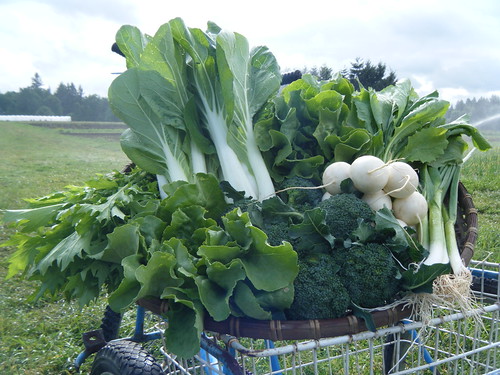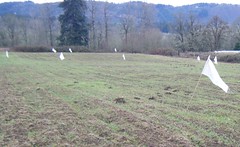This Week’s Share
Share Notes
- Chard: Say hello to your first round of chard. You will see chard in the spring and fall. The chard plant is actually the same species as beets – Beta vulgaris. Chard varieties are bred for their leafy tops, while beets are bred for their roots.
- Red Choi: These baby heads of red choi are a real spring treat. You may notice some have a budding stem. The stem and flower buds part are both edible, so try it out in your next stir-fry.
- Onion, Siskiyou Sweets: Spring onions are here! For the first distribution you will receive Siskiyou Sweets (similar to Walla Walla Sweet Onions). Here at SIO your first distributions of onions were planted in early October from transplants started in the greenhouse in July. These onions are over-wintered in our fields so they are ready for early harvest in the spring. The flower stalk has started to form in the center, at the farm we call this bolting. We harvest these bolting onions for an early taste of onions in the share because there is still a usable portion of bulb around the flower stem. We have left a portion of the onion tops because you can use that too.
- Spinach: You will receive a pound of beautiful and sweet spinach this week in your share. Use this for a delicious spinach salad, or in your favorite cooked spinach recipe. As usual, please be sure to wash thoroughly before eating.
Recipes
Chard Recipes
Chard and Feta Tart
Adapted from Eating Well in Season by Jesse Price
For the crust:
¾ cup whole-wheat pastry flour
¾ cup all-purpose flour
1½ tablespoons chopped fresh thyme or oregano (or ½ teaspoon dried)
¾ teaspoon salt
¾ teaspoon freshly ground pepper
1/3 cup olive oil
5 tablespoons cold water
Combine whole-wheat flour, all-purpose flour, thyme (or oregano), salt and pepper in a bowl. Make a well in the center and add the 1/3 cup oil and 5 tablespoons water. Gradually stir the wet ingredients into the dry to form a soft dough. Knead on a lightly floured surface until the dough comes together. Wrap in plastic and chill for 15 minutes
Pre-heat the oven to 400˚F. Coat a 9-inch tart pan with removable bottom with non-stick cooking spray/shortening/butter. Roll the dough into a 12-inch circle on a lightly floured surface. Transfer to the prepared pan and press into the bottom and up the sides. Trim any overhanging dough and use it to patch any spots that don’t come all the way up the sides. Prick the bottom and sides with a fork in a few places. Bake the crust until firm and lightly browned, 20-22 minutes. Let cool on a wire rack for at least 10 minutes.
For the filling:
2 teaspoons olive oil
6 cups chopped chard, leaves and stem separated
2 tablespoons garlic, minced (use green garlic if you have some)
2 spring onions, sliced
2 tablespoons water
2 large eggs
1 cup part-skim ricotta cheese
1 teaspoon freshly grated lemon zest
1/8 teaspoon freshly ground pepper
½ cup chopped pitted kalamata olives
1/3 cup crumbled feta cheese
While the crust is chilling and pre-baking, you can get started on the filling. Heat 2 tablespoons oil in a large skillet over medium heat. Add chard stems and cook, stirring, until just tender, about 2 minutes. Add garlic and onions and cook, stirring, until fragrant, about 15 seconds. Add chard leaves and 2 tablespoons water and cook, stirring, until leaves the leaves are just tender and the water has evaporated, 2-5 minutes. Transfer the greens to sieve over a bowl and let drain and cool for 5 minutes. Whisk eggs, ricotta, lemon zest and 1/8 teaspoon pepper in to a large bowl. Fold in the greens, olives, and feta. Spread the filling into the crust. Bake the tart until the top is lightly browned and a knife inserted in the center comes out clean, 30 to 35 minutes. Let cool for 10 minutes before cutting into wedges.
Spring Vegetable Braise
Adapted from Local Flavors by Deborah Madison
2-3 spring onions (could substitute green garlic if you have some left)
4 cloves of garlic, minced (use only if you are not including any green garlic)
6 carrots, 3-4 inches long (optional)
1 bunch hakurei turnips, with tops (also can use any radishes you may have left)
1-2 heads red choi, chopped into bite size pieces
8 chard leaves, sliced into strips (you many use the stem if desired)
sea salt and freshly ground pepper
2 tablespoons unsalted butter
2 tablespoons finely chopped parsley
1 tablespoon finely chopped tarragon
1 tablespoon fresh lemon juice
Slice the onions about ¼-inch wide. Cut all but ½-inch of the carrot greens off, peel the carrots, and slice them in half lengthwise. Leave ½-inch of the turnip/radish greens attached. Leave the smaller ones whole, and cut the larger ones into halves or quarters.
Bring 6 cups water to a boil and add 1 ½ teaspoons salt. Blanch the carrots (if using), turnips/radishes for 7 minutes, then scoop out and set aside (no need to rinse them). Keep the cooking water for using later. Melt half the butter in an 8- or 10-inch sauté pan. Add the onions and cover over medium heat for about 2 minutes, stirring frequently. Add ½-cup of the vegetable cooking water, the blanched vegetables, half the herbs, and ½-teaspoon salt. Simmer until the vegetables are fully tender, 10 to 15 minutes, adding water in 1/3 cup increments so that the pan doesn’t dry out. There should be a little sauce.
Add the remaining butter and lemon juice. Then add the red choi and chard and raise the heat and swirl the pan back and forth until the butter has melted in to the juice. Remove from the heat after 3-4 minutes, and add the rest of the herbs, season with pepper, and serve. This is great mixed in with pasta, or as side with fish or chicken.
Hakurei Recipes
Quick-Pickled Turnips
From The Joy of Picking by Linda Ziedrich
1 pound hakurei turnips (half your bunch this week), trimmed at the top and bottom
2 teaspoons pickling salt
1½ cups water
1 fresh red jalapeno pepper, seeded and minced, or 1 tablespoon minced pimiento
3 tablespoons sugar
1½ cups rice vinegar or white vinegar
Score each turnip several times at top and bottom. Put the turnips into a bowl. Dissolve the salt in the water, and pour the brine over the turnips. Let them stand for 30 minutes to an hour. Drain the turnips well, then return them to the bowl with the minced pepper, and toss well. Combine the sugar and vinegar, and stir until the sugar dissolves. Pour the liquid over the turnips. Cover the bowl with plastic wrap, and refrigerate and the turnips for two days, after which they will be ready to eat. Well covered and refrigerated, they will keep for several months.
Fresh Greens Salad with Hakurei Turnips
From the Sauvie Island Organics Crew
3 cups spinach, whole and lightly packed
1 bunch mizuna (may increase or decrease quantity depending on needs)
2-3 hakurei turnips, sliced
2 tablespoons sunflower seeds, toasted and chopped nuts (optional)
2-3 tablespoons of Asian Salad Dressing (recipe below) or dressing of your choice
Wash lettuce, mizuna, and turnips. Leave the mizuna whole, and tear or chop lettuce into smaller pieces and place in salad bowl. After slicing the Hakurei turnips place them in the salad bowl as well. Add seeds or nuts as desired, dress, and toss.
All-purpose Asian Salad Dressing/ Marinade
Adapted from Astray Recipes, www.astray.com
Note: This dressing is great with fresh greens, sautéed greens, steamed vegetables, and cold meats as well as any other applications you may create for it.
2 tablespoons white vinegar
1½ tablespoons soy sauce
1 tablespoon plus 1 teaspoon sugar
1½ sesame oil
½ teaspoon fresh ginger, grated
1 tablespoon cilantro, chopped
a few drops of hot pepper oil (optional for those with aversions to spiciness)
Place all ingredients in a bowl or salad dressing jar and mix or shake vigorously to ensure everything is well blended. Use as desired.
Spring Vegetable Braise
(see above in Chard Recipes)
Spinach Recipes
Spinach Salad
Adapted from Territorial Seed Garden Cookbook
¼ oil
¼ cup vinegar
¼ cup sugar
1 teaspoon rosemary, chopped
½ teaspoons salt
2-4 turnips, sliced into ¼-inch rounds (could use radishes)
1-2 spring onions, sliced into rings
4-6 cups spinach, lightly packed
Make a marinate of the oil, vinegar, sugar, rosemary, and salt. Slice turnips (or radishes) and onions into rounds/rings, and soak in marinade for as long as possible. Clean spinach and tear into bite-sized pieces if needed. Drain off marinade (it can be reused if kept in the refrigerator) and add turnips and onions to spinach. Toss and serve.
Catalan Spinach
From Fresh from the Farmers’ Market by Janet Fletcher
2 teaspoons dried currants
1 tablespoon pine nuts
1 pound fresh spinach (your share this week)
2 tablespoon olive oil
1 large clove garlic (or 1 stem green garlic), minced
2 dried apricots, diced into 1/8-inch pieces
Salt and freshly ground black pepper
Place currants in a small bowl with warm water to cover and let stand for 30 minutes to soften, then drain. Preheat oven to 325˚F. Toast pine nuts on a baking sheet until they are golden brown and fragrant, 12 to 15 minutes. Wash spinach well in a sink filled with cold water. Remove and discard any thick stems, and drain leaves in a colander. Place spinach in a large pot with just the water clinging to the leaves from washing as the your cooking liquid. Cover and cook over moderate heat, stirring occasionally, until leaves are just wilted, 3 to 5 minutes. Drain in a sieve under cold running water. Squeeze between your hands to remove excess moisture.
Heat olive oil in a 10-inch skillet over moderate heat. Add garlic and sauté until it colors slightly, about 2 minutes. Add spinach, tossing to separate the leaves and coat them with oil. Add currants, pine nuts and dried apricots. Toss to distribute evenly. Season with salt and pepper. Cook, stirring occasionally, until spinach is hot throughout, 2 to 3 minutes. Serve immediately as a side dish.















